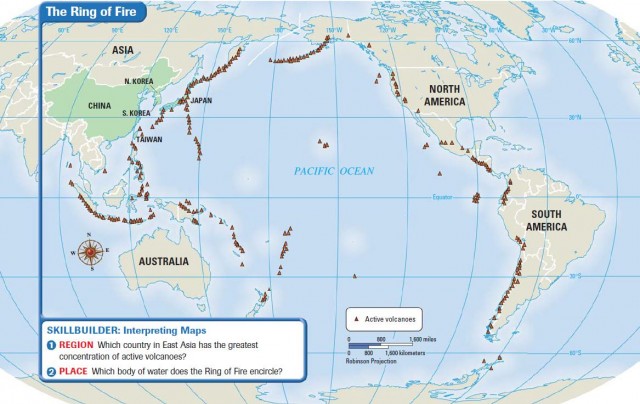East Asia: The Ring of Fire
A HUMAN PERSPECTIVE On January 17, 1995, at 5:46 A.M., a severe earthquake rocked Kobe, Japan's sixth largest city. When the dust settled and the last of the fires burned out, about 6,000 people lay dead, and more than 40,000 suffered injuries. The government quickly began rebuilding the port city, but psychologists warned that reviving the spirit of Kobe's people would take time. Many lost family members. Entire neighborhoods vanished. A year after the quake, nearly 50,000 people were still living in temporary shelters, and anger grew against the government. Clearly, much more than glass, steel, bricks, and mortar would be needed to bring Kobe fully back to life.
Physical Forces in the Ring of Fire
Like Kobe, many Japanese cities are threatened by earthquakes. This is because Japan is part of the Ring of Fire—a chain of volcanoes that line the Pacific Rim.
SHIFTING PLATES
As you learned in Unit 1, the outer crust of the earth is made up of a number of shifting tectonic plates that continually bump and slide into each other. When a dense oceanic plate meets a less dense continental plate, the oceanic plate slides under the continental plate in a process called subduction. The area where the oceanic crust is subducted is called a trench.
In East Asia, the Pacific oceanic plate encounters the Eurasian continental plate. When the oceanic plate moves under the continental plate, it crumples the continental crust, building mountains and volcanoes such as those that form the Ring of Fire.
At the same time, tremendous stress builds up along the edges of the plates. The stress keeps building until eventually the plates move suddenly and violently. The result is an earthquake.
The Geology of Japan
The Japanese islands exist because of subduction. The islands were formed by volcanoes created as the Pacific plate slid under the Eurasian plate. But the same forces that build islands can also destroy them.

VOLCANOES
Living along the Ring of Fire means living with volcanic activity. From the time historical records were first kept, at least 60 volcanoes have been active on the islands of Japan. In fact, the best-known landform in Japan, Mt. Fuji, is a volcano.
EARTHQUAKES AND TSUNAMIS
Earthquakes like the one that destroyed Kobe are common in Japan. An average of 1,000 quakes occur there each year. Most are too mild to affect people's lives. Some, however, cause many deaths and massive destruction. In 1923, the Great Kanto earthquake and the fires it caused killed an estimated 140,000 people and left the city of Tokyo in ruins. The quake partially or completely destroyed nearly 700,000 homes.
Another geological threat to Japan comes from the sea. When an earthquake occurs under the ocean floor, part of the floor moves. If the quake is strong enough, this shift may produce a tsunami, a huge wave of great destructive power. Underwater volcanic eruptions and coastal landslides can also cause tsunamis. Some waves have reached heights of over 100 feet.
Preparing for Disasters
For thousands of years, people have tried to predict when natural disasters will occur. At the dawn of the 21st century, they are still trying. Vulnerable nations like Japan are working to improve their defenses against the destructive power of geological forces.
PROBLEMS
Many older buildings in Japan are not as likely to withstand earthquakes as newer buildings. In addition, some buildings have been constructed on ground or landfill that is not very stable. Underground gas lines are likely to rupture in the event of an earthquake, and leaking gas can catch fire. Crowded blocks and narrow streets spread the fires and hinder rescue operations.
SOLUTIONS
Japan has established a strict building code. Whenever a quake rocks some area of the nation, engineers are quick to study how different types of buildings withstood the heaving ground beneath them. The results of their studies affect building codes governing construction materials and techniques. This has made newer buildings safer than older ones.
Because of the dangers, the Japanese people understand the importance of being prepared for disasters. Schoolchildren participate in yearly disaster drills with local fire-fighters. Organizations like the Japanese Red Cross Society and the Asia Pacific Disaster Management Center offer courses on disaster preparedness and management.
Japan and the other countries along the Ring of Fire cannot change the geology that shapes their land. They can, however, learn more about it and prepare to deal with disaster when it strikes next.